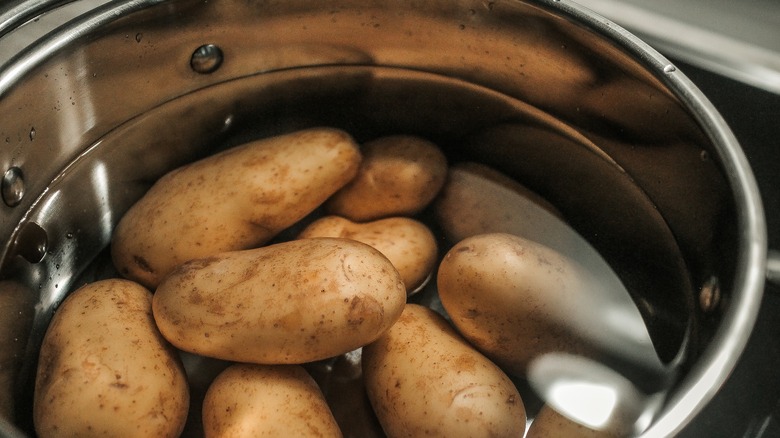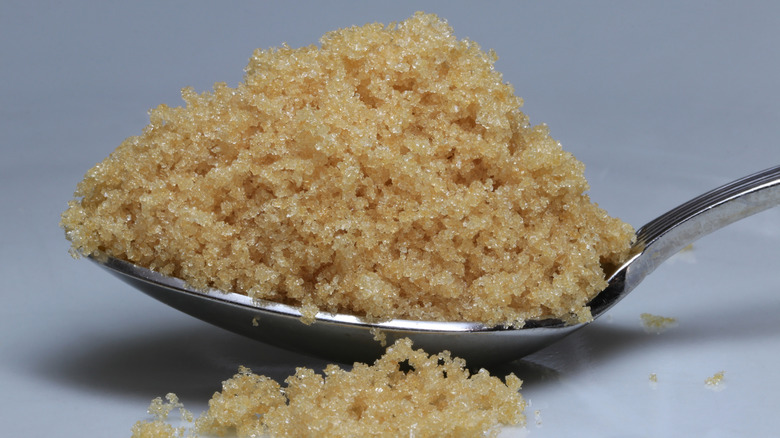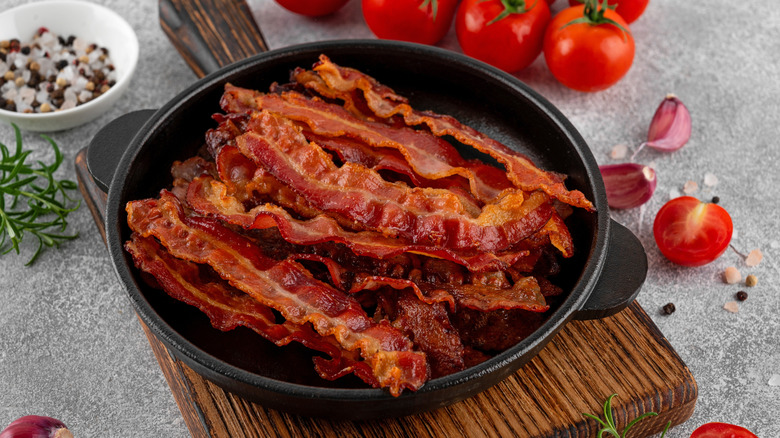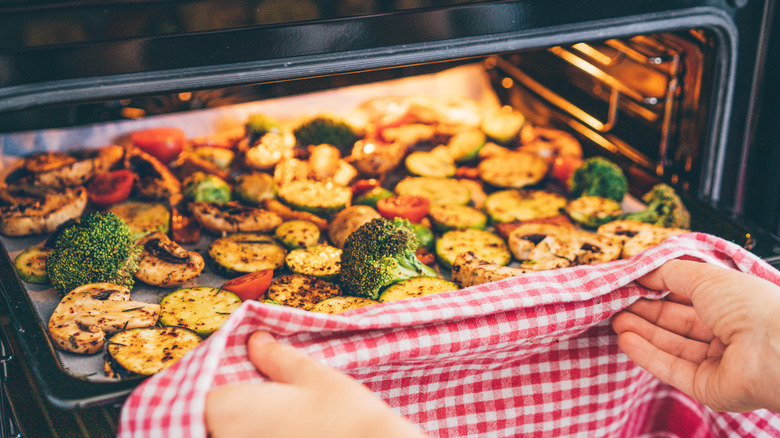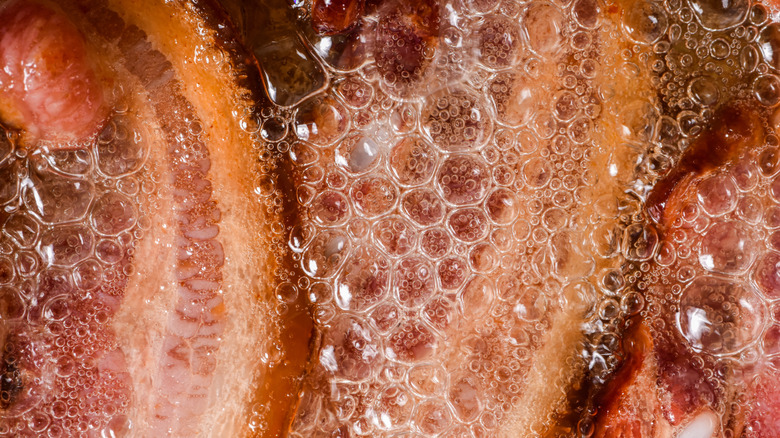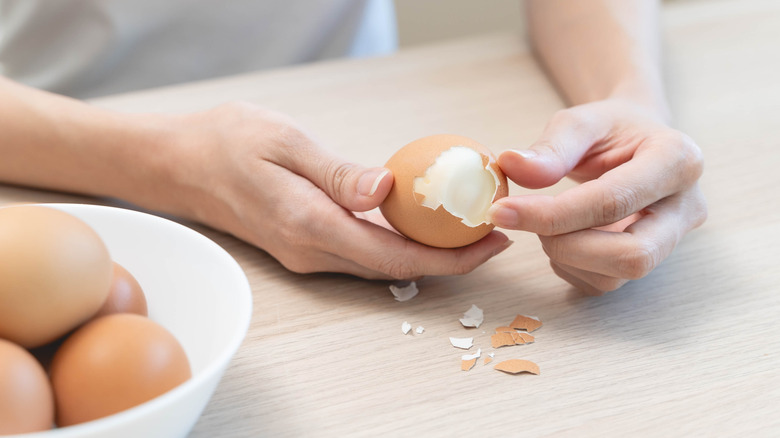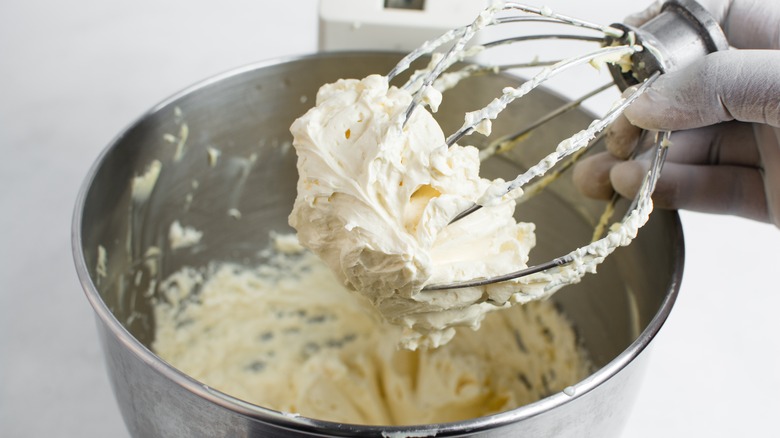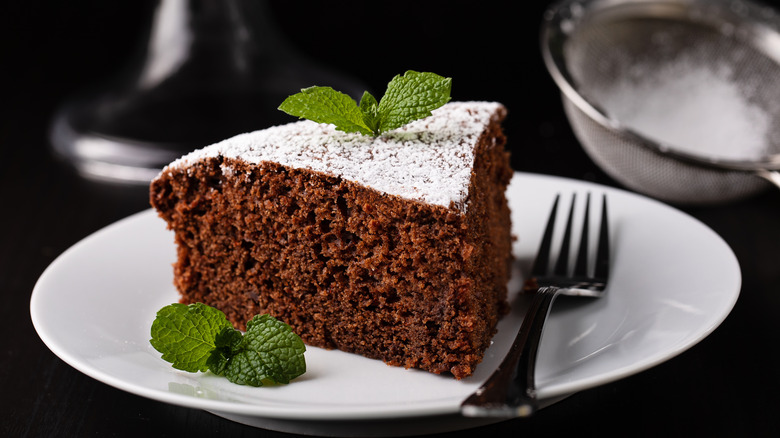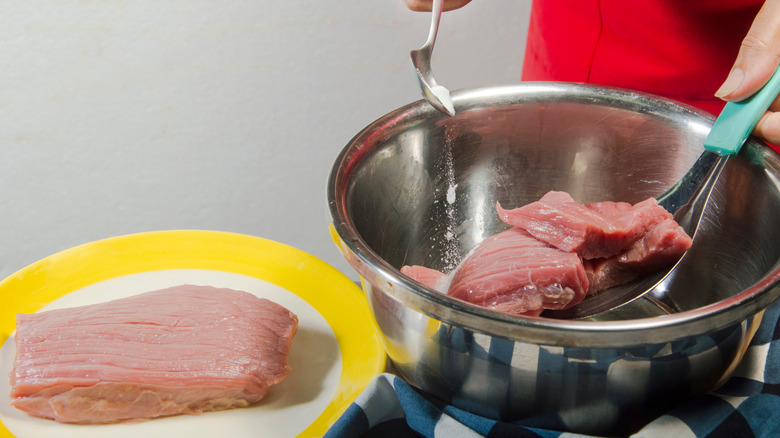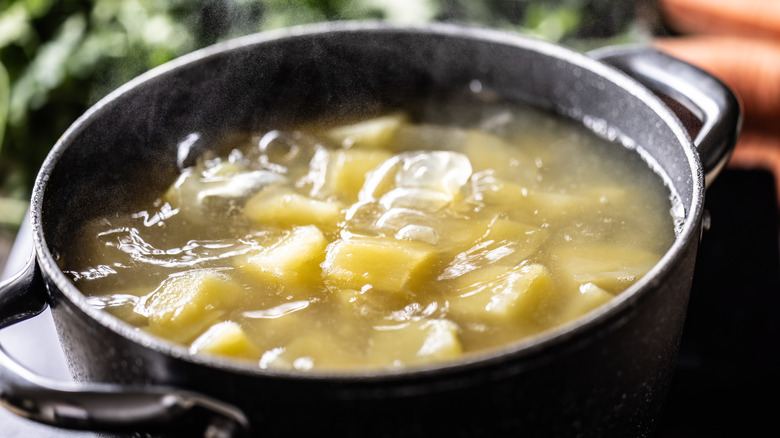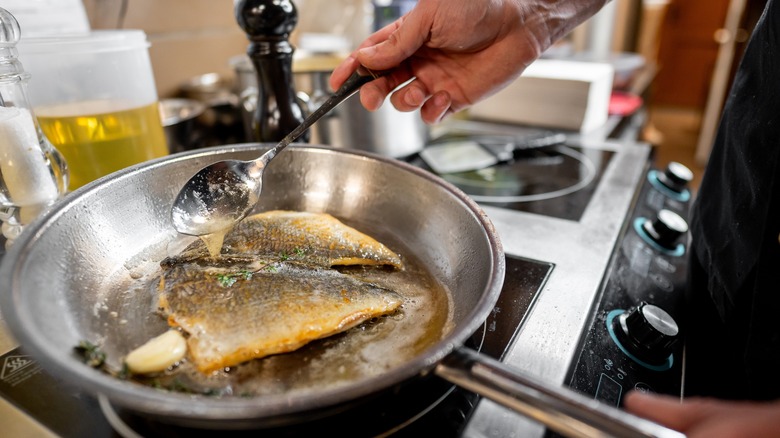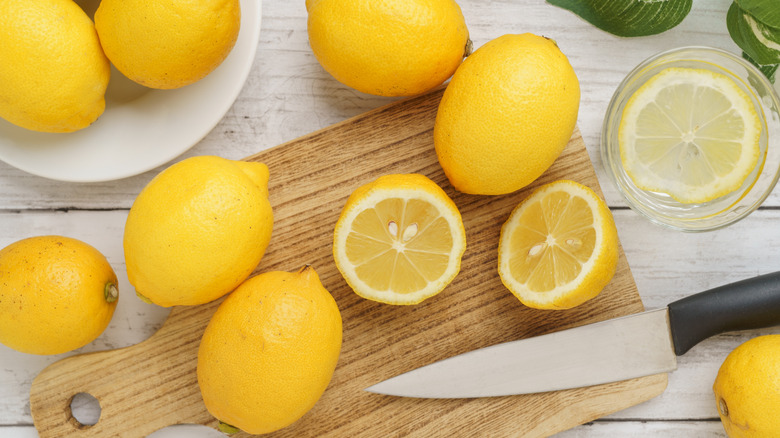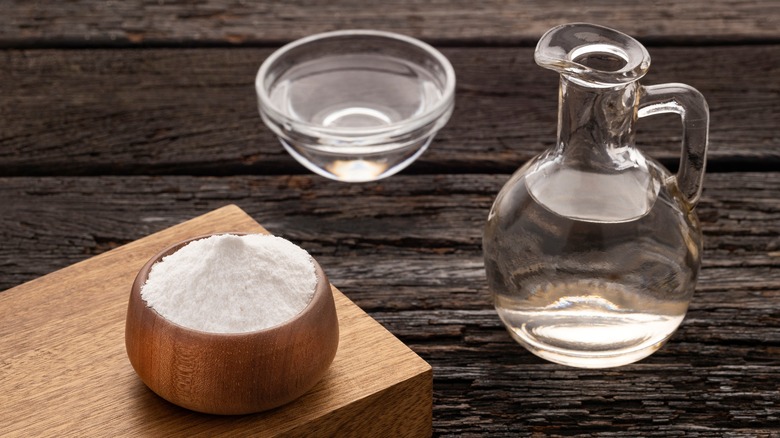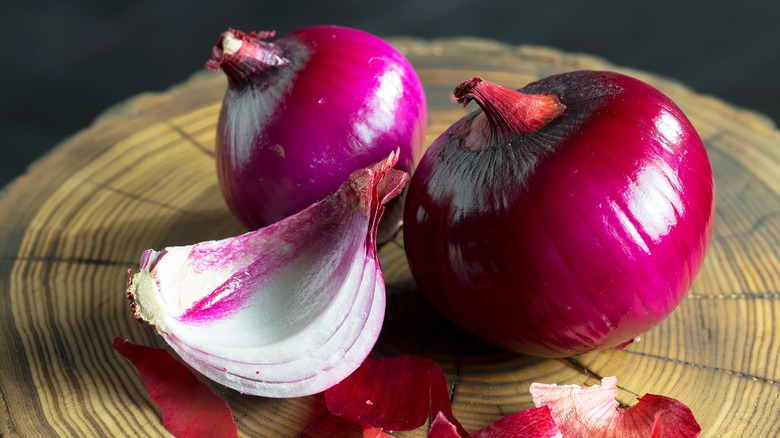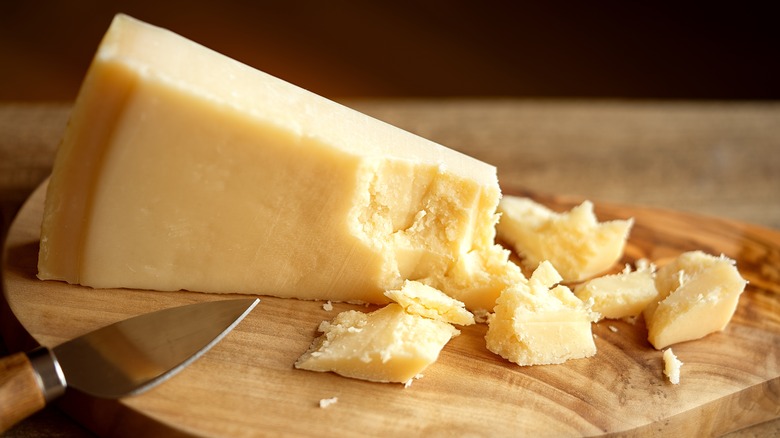17 Old-School Cooking Hacks That Are Nearly Forgotten
There's a reason so much of social media is devoted to cooking hacks. Everyone and their mother — or grandmother — has a few nifty tricks that make cooking a little easier or more interesting. But with so much guidance out there, it's inevitable that some excellent kitchen hacks get lost in the shuffle over time due to changing tastes and information overload.
Sometimes, looking to the past is the answer. Leafing through cookbooks and listening to the advice of grandparents can provide a wealth of old-school culinary knowledge and no shortage of hacks that save time and improve your cooking. These tricks offer up ways to store you food for longer, imbue your dishes with bolder and more enchanting flavors, or simply make your life easier when throwing together a quick weeknight dinner. Like many cooking hacks, they might require some extra care and attention to get right, but you surely won't argue with the tasty results.
Start your potatoes in cold water
Whether you are roasting, baking, or mashing your potatoes, the old-fashioned secret to the best texture starts in the same place: cold, salted water. It may seem overly simple, but the results are staggeringly scrumptious.
For baked potatoes, dip the spuds in cold, salted water before the oven to guarantee an extra crispy skin while the inside stays fluffy. For roasted potatoes, a 30 minute to one hour soak in a simple salt water and baking soda brine beforehand is essential for taters that are golden on the outside and pillowy soft within (just make sure to pat them very dry afterwards). And for mashed potatoes, putting the potatoes in a pot of cold, salted water and bringing them to a boil ensures the classic cloudlike texture. Adding potatoes to already-boiling water causes the starch to react to the heat, creating a gummy texture which is less than ideal.
Soften hard brown sugar with bread
Few things are as disappointing as starting on a cookie dough, reaching for the brown sugar, and finding lumps of molasses-flavored rocks instead. Humidity is to blame — the extra moisture in brown sugar that helps make it so delectable also can lead to trouble if it starts to evaporate. When that happens, the sugar clumps and crystalizes.
Storing your brown sugar in an airtight container can help prevent the problem, but what about brown sugar that's already become transformed into unwelcome rock candy? The surprising solution, hidden in ancient cookbooks, is literally any slice of fresh bread. Bread, when placed in a container with brown sugar, gradually releases its own moisture, which the crystallized sugar eagerly drinks up. The result is the sugar relaxing back into its normal, measurable state again. This process does take hours and preferably overnight, so best to plan it out ahead of time.
Cook your pasta in stock for an easy meal
The best thing about old-school cooking hacks is that they almost always feel like commonsense wisdom. Most people know that it's good to finish cooking your pasta in cooked sauces, such as marinara or Bolognese, for the best flavor. But some don't know that, with the right ingredient, you don't even need the sauce. You could, in fact, make a beloved Italian one-pot meal with two ingredients.
Cooking your pasta in stock instead of plain old water imbues your pasta with a deep savory flavor. Better yet, as the pasta releases its starches into the stock, it will start to thicken into a sauce all on its own. Add a few fresh herbs, a little sprinkle of cheese, or maybe a touch of pesto, and presto! Dinner is served. Even vegetarians can get in on the action by using vegetable stock, and of course it's also the secret to the best chicken noodle soup you've ever tasted. The trick is to use thin or small-shaped pasta that will readily absorb the flavor of the stock, and to carefully ratio the stock and pasta: About a quart of stock per quarter pound of pasta should do the trick. Oh, and don't forget to use a high-quality stock.
Sprinkle your bacon with flour before cooking
Some people will find the idea that bacon could need any improvement laughable. Yet, with a simple sprinkle of one of the most common pantry items, you can ensure a 10-out-of-10 bacon experience every time.
Before frying or baking your bacon strips, give them a light dusting of flour. Alternatively, you can lightly dredge bacon in flour as you would for breading it for frying. Rather than altering the flavor of the meat, the flour will absorb the excess grease as the bacon cooks, giving each strip the maximum possible crunch. Flour also prevents bacon from curling as it cooks, which helps it cook evenly, so no more weird burnt or undercooked parts. The key is to use a light touch when adding the flour; add too much and you'll find bits of burnt flour or greasy dough around your breakfast. Get it right and you'll enjoy a symphony of crunchiness morning, noon, and night.
For the best roasted vegetables, use sugar
Children often hear the refrain "you have to eat your vegetables." Even some adults struggle with getting their greens in. However, all is not lost, because there's an old-school secret to making vegetables the king of the dinner table. Hilariously, it uses what might be considered vegetables' culinary opposite.
Before you roast your vegetables, sprinkle them with a little bit of sugar. Vegetables contain natural sugars, but the addition of some extra encourages caramelization in the oven, giving them a lovely golden-brown crust and enhancing their flavors. Sugar-sprinkled vegetables are toasty, buttery, and tantalizing. You can even experiment with your choice of both sugar and vegetable to find your favorite combination. For example, try sweet potatoes with maple syrup or honey with beets. As with many old-school hacks, this one comes with a caveat: Make sure you use a light hand when adding your choice of sugar. Otherwise you'll end up with vegetable-flavored candy, which, while intriguing conceptually, probably isn't the best choice for a side dish.
Save your drippings for future flavor bonuses
This hack hearkens back to at least the Great Depression, if not further. Every grandparent and yellowing cookbook will tell you the same thing: Don't throw out your bacon grease, because it's worth its weight in gold.
Bacon grease contains deep, endorphin-rush levels of umami flavor, and there really is no limit to its uses in the kitchen. You can use it as the base for a pan-sauce, caramelize onions or cook eggs in it for added savoriness, and even add it to pie crusts instead of butter to create a contrast with the sweet fillings. This doesn't just apply to bacon grease, either — the drippings from all your meats can be saved and used in the same manner. This technique used to be unquestioned in past eras, but health-consciousness in modern times dampened enthusiasm for it. It may not be ideal for every person, but if you want a little extra flavor in your food, you'll be hard-pressed to find a simpler method.
Add baking soda to make egg peeling easy
There are few more persnickety and vexing challenges than trying to peel an egg perfectly with no chunks going missing or having to clean up dozens of tiny shell pieces. All the patience in the world can't help you if the shell insists on clinging to the egg whites and ruining your plans for perfect deviled eggs.
However, a well-tested but mostly forgotten cooking hack can completely change the way you look at hard-boiled eggs. Just add about ½ teaspoon of baking soda to the boiling water. The alkaline solution helps loosen the membranes that connect the shell to the whites, so they come off much easier after cooking and the traditional quick ice bath. The baking soda actually mimics a similar process that occurs when eggs age, which is why older eggs tend to be easier to peel. Oh, and much like potatoes, you should start the eggs in cold water, as that also helps with peeling as well as ensuring the best texture.
To avoid buttercream headaches, make Russian buttercream
Making fresh buttercream is often a hassle. Getting the ratio of powdered sugar, butter, and milk is rarely an exact science at the best of times, and even when you do manage it, the results can often taste grainy and overly sweet.
Well, it turns out there's a better way, as any old-school home baker will tell you. Russian buttercream forgoes the typical powdered sugar route and instead uses just sweetened condensed milk and butter beaten together, which leads to a more balanced frosting with no graininess. It's far easier to whip together, so even more novice home bakers can enjoy bakery-level baked goods. And it's easy to flavor Russian buttercream and make it ahead of time. The key is to make sure the butter is properly prepared. Five minutes whipping at room temperature butter before adding the sweetened condensed milk should get the results you want.
Add salt to your coffee for boosted flavor
Cream or sugar? Well, now there might be a third option for your coffee: salt. It turns out adding a little sprinkle of table salt can transform your morning brew in ways you didn't realize.
Adding salt to coffee is not a new idea – it's been common practice for centuries and is popular in parts of Scandinavia, Vietnam, and Turkey, but hasn't quite reached mainstream American coffee culture, which is a shame. Salt works to enhance coffee's flavor while cutting back on its natural bitterness, which is a huge boon to those looking to cut back on sugar. Plus, it can act as a water softener, removing any stale flavor from the water. The key is knowing when to add the salt; for French press coffee, add the salt with the grounds, while with cold brew it's better to do so at the end. Make sure not to use too much!
Incorporate mayo into your batter for more tender cakes
This is a true old-school kitchen hack, dating back to at least the 1930s (if not earlier). Despite how off-putting the idea may seem in the abstract, adding mayonnaise to your cake batter makes perfect sense.
Mayonnaise is just an emulsion of eggs and oil, both of which are essential to baking cakes. Because it is an emulsion, the mayonnaise coats the flour in the cake batter and therefore helps prevent gluten development, leading to a more tender texture. The mayo also imbues the batter with extra moisture, which can result in a softer cake.
However, there's a catch: Adding too much mayo can cause the cake to become denser and mess with the flavor. For a boxed cake mix, you generally want to use ⅓ cup of mayonnaise in place of the called-for oil, or substitute half of the called-for oil with mayo for a more balanced experience. You may also want to seek out recipes that already incorporate mayonnaise if you don't feel like experimenting.
Tenderize your meats with baking soda
"Velveting" is an old-school tenderizing method that's astonishingly easy to pull off. It turns out a quick brine with baking soda can transform even tough cuts of meat into melt-in-your-mouth tender morsels.
Baking soda messes with the fibers of the meat, making it harder for them to bind together and thus softening them. All you need to do is toss chunks of steak or chicken in about ¾ teaspoon of baking soda before pan-frying. Alternatively, you can dry brine your meat in about 1% of its weight in baking soda and allow it to rest in the refrigerator for a few hours. For a faster brine, you can wet brine the meat in a solution of 1 teaspoon of baking soda and ½ cup water for every 12 ounces of meat and then let it sit for 15 minutes. Just remember to thoroughly rinse and pat dry the meat after its brining, either wet or dry.
Save your potato water for great soup
Unsurprisingly, home cooks of bygone eras had to make do with less or find novel ways to use what might seem, at first glance, to be useless food byproducts. Such is true even of the leftover water used to boil your spuds for mashed potatoes.
When you boil potatoes, they release their starches, turning ordinary water into a versatile thickening agent. Potato water can add body to pan sauces and soups, add flavor to bread doughs, and be used in place of flour as a gluten-free substitute. As an added bonus, potato water contains a lot of proteins and nutrients, so it can actually helps make foods healthier (plus it makes a great fertilizer for your home garden). Make sure you refrigerate your potato water for at least a day or two and that you peel your potatoes before you boil them, as unpeeled potatoes don't release enough starch.
Check hot oil with a cube of bread
The problem with cooking thermometers is their size. Those things just disappear into the ether, just like rice cooker attachments. And they always tend to vanish right when you need to make sure your cooking oil is the right temperature.
Fortunately, old-school chefs have a few simple ways of checking to make sure the oil is not too hot or too cold (you want something between 325 degrees and 375 degrees Fahrenheit). One of the simplest involves a humble slice of bread. Cut the bread into a 1-inch cube and drop it into the hot oil. If it turns golden brown in 50 seconds to one minute, your oil is ready. You could also drop a single unpopped kernel into the hot oil to see if it pops, but the bread cube also provides a tiny snack with more crunch than a single popcorn kernel. Frying just got more fun.
Clean your cutting board with lemons
This hack is a bit controversial. There's a good amount of evidence that simple soap and water are more effective for cleaning some cutting boards, especially wooden ones; the flavor of the lemons can seep into porous wood. However, old-school cooks will swear by cleaning your cutting boards with lemon, and there's a lot of reasons to believe them.
Lemons are naturally acidic, and those natural acids can do a lot of heavy lifting. It can remove stains, kill bacteria, and (unsurprisingly) bestow a lovely lemon scent on your cutting boards. According to home chefs, the lemons really do make the boards look and smell fresh, and it gives you a use for those old citruses taking up space in the fridge. You even combine the lemon with a bit of coarse salt for extra scrubbing power. Depending on the material of your cutting board, you might just want to incorporate the lemon trick into your regular cleaning schedule.
Employ vinegar and baking soda as an egg substitute
Eggs being prohibitively expensive is nothing new. During the Great Depression, home bakers had to use what they could get their hands on when eggs were out of reach. And one particular trick is still viable for your cakes to this day.
All you need is 1 tablespoon of vinegar and 1 teaspoon of baking soda to replace one egg. The acid in the vinegar causes the baking soda to froth and bubble, creating an incredible rise for cakes, cupcakes, and muffins. Amazingly, the substitute doesn't leave a vinegar flavor behind either, so no worries about any strange sourness in your cake. However, the tradeoff for this substitute is that the mixture adds extra liquid to the batter, which means you'll have to adjust the dry ingredients accordingly. Also, you might need to find an alternative binding agent, as neither the vinegar or the baking soda will manage that part. Don't forget to mix the vinegar and baking soda separately before adding it to the batter!
Reduce red onion potency with a quick soak
Raw red onions can be an overpowering addition to recipes, and yet they are also an ever-present component in cooking and garnishing sandwiches, salads, and so much more. Some people aren't so fond of the sharp spice that red onions bring to the table. But fortunately, chefs with a little classic know-how have a way of tempering red onions.
To get red onions to play nice with other ingredients, slice them and soak the slices in ice water for 30 minutes to an hour. You can also give them a little extra punch of flavor that won't overpower by soaking them in salt water or vinegar for a quick pickle process. The longer the soak the better, but even a 15-minute bath can cut the potency by quite a bit. In fact, you can even reduce the red onion sharpness with a vigorous rinse under cold water from the sink.
Preserve your cut cheese with butter
This isn't a dairy conspiracy or a delicious indulgence (well, it might also be the latter). Instead, it's a great way to preserve your cut cheese with a little extra richness to boot.
The cut edge of your cheeses is vulnerable to fungal spores, oxidation, and moisture, which could lead to mold or unappetizing dryness. However, the old-school trick of rubbing some butter on the cut edge essentially cuts the cheese off from the outside world. It prevents oxidation thanks to butter's high fat content and prevents mold from reaching the much more vulnerable cheese. You should still keep your cheese in wax paper or an airtight container, but even a small square of butter can greatly increase the shelf life of your favorite cheddar or Gouda. This trick does give your cheese a slight buttery taste to it, although depending on your preferences, that might not be so bad.


